Guillermo del Toro Helped ‘True Detective: Night Country’ Craft Its Chilling Corpsicle
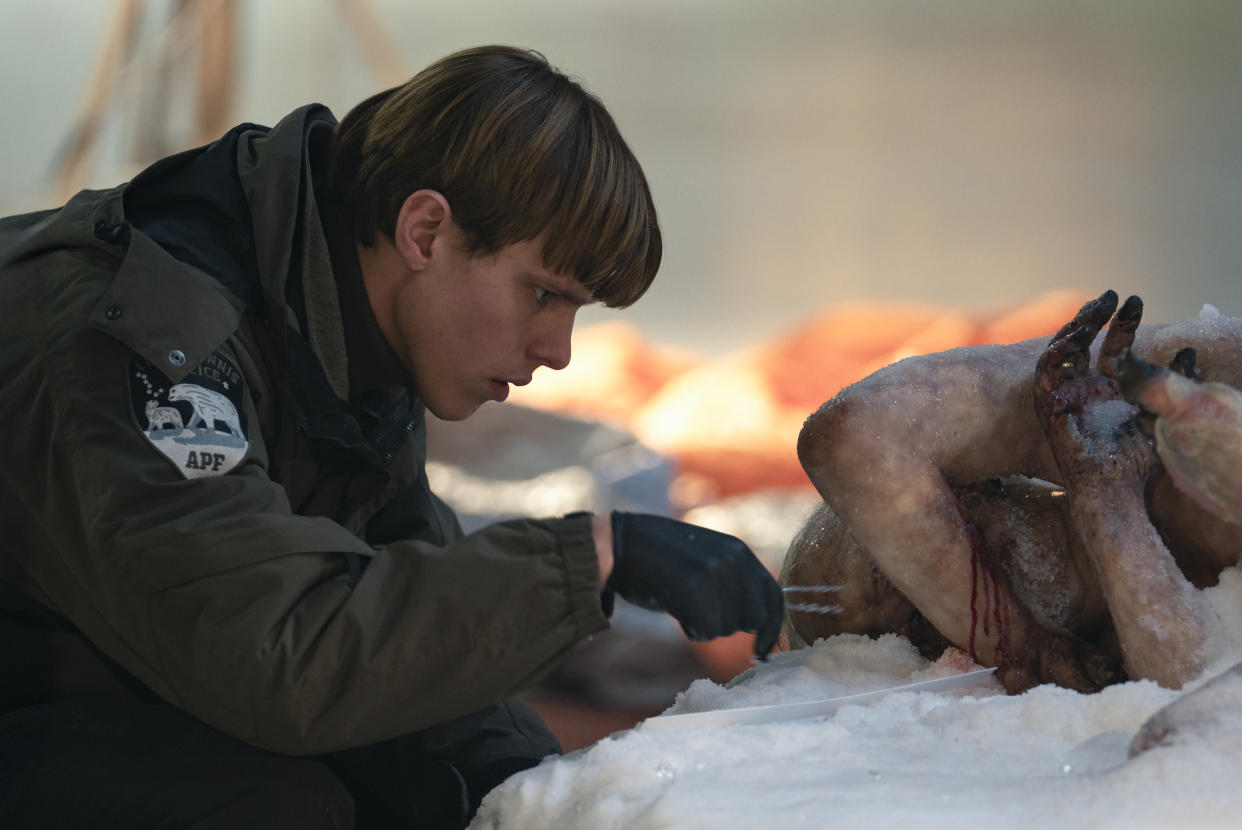
- Oops!Something went wrong.Please try again later.
- Oops!Something went wrong.Please try again later.
[Warning: This post includes spoilers for “True Detective: Night Country.”]
Twisted engravings from Dante’s “Inferno,” mummified bodies from Mexico, and a phenomenon where rats’ tails get entangled and they thrash and flail and maul each other until they die: These may not be a few of your favorite things but they are a few of “True Detective: Night Country” showrunner Issa López’s key influences for the extremely cold case detective Liz Danvers (Jodie Foster) has to solve.
More from IndieWire
With Its Oscar Nomination, 'Godzilla Minus One' Brings Takashi Yamazaki into an Exclusive Club
Dakota Johnson Reflects on Her Short 'The Office' Stint: 'The Worst Time of My Life'
Dubbed “The Corpsicle” as far back as the scriptwriting, López knew that the snarl of naked bodies — once the scientists at Tsalal research station before they, somehow, all wound up (mostly) underneath the ice — would not only be another entry in the “True Detective” pantheon of grotesque murder tableaus, but it would visually cement the tone for Season 4’s blend of crime procedural, alienation from nature, and the looming dark of something supernatural. If the bodies weren’t shocking in exactly the right way, the series would be dead in the (frozen) water.
“The script at the end of Episode 1 reads: ‘The naked, mutilated bodies of at least four men are frozen solid on the icy ground, partly covered in the hardening snow. The wild expressions of pure panic on their faces are almost not human, but still we recognize the faces from the Tsalal Station: Molina, Jie, Lund, Emerson. Naked. Dead. Frozen. And absolutely terrified,'” López told IndieWire.
That reads great. But López the writer also knew in addition to action lines, she was writing a big check that López the director and the rest of her production team would need to be able to cash. “I decided to ask the master of horrible creatures, and I called Guillermo del Toro. And I was like, ‘Maestro, I’m going to be shooting in Iceland. So I need someone in the U.K…. I need someone who can create something as complex as this.’”
Del Toro recommended Dave and Lou Elsey of Igor Studios. They and their team oversaw the build of the corpsicle and joined “True Detective: Night Country” production designer Daniel Taylor, VFX supervisor Barney Curnow, and cinematographer Florian Hoffmeister in contributing to the frozen horror that Rose Aguineau (Fiona Shaw) discovers just outside of Ennis, Alaska. IndieWire spoke to López, Curnow, the Elseys, Hoffmeister, and Taylor about each stage of the process of bringing the corpsicle to life — and death.
The Initial Planning
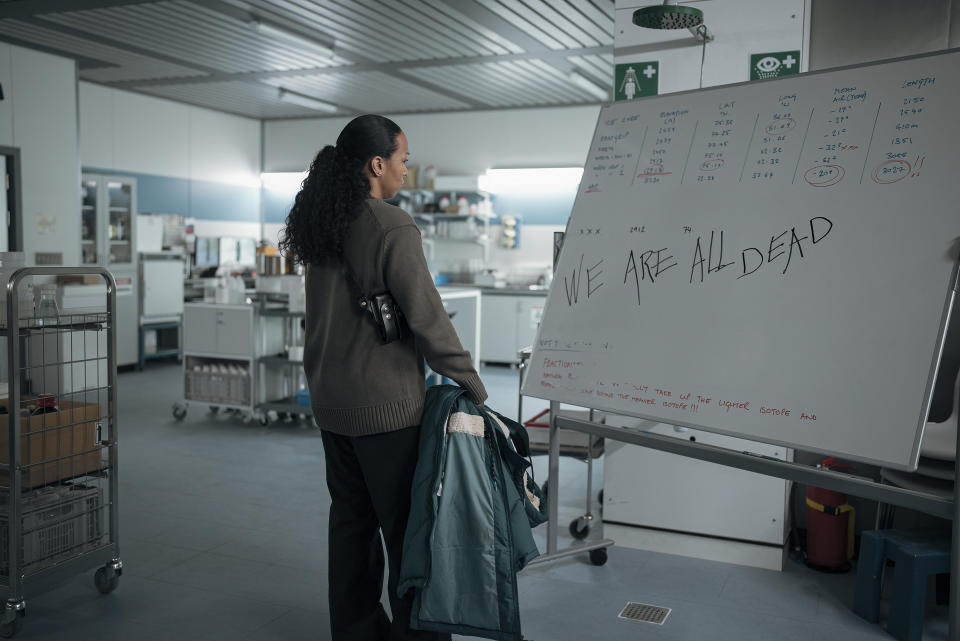
López has some truly demented Pinterest boards where she stashed inspiration for what would become the corpsicle. But while broaching the subject of creating a TBD number of full, naked frozen corpses (“Usually you have clothes to hide loins and things like that,” Dave Elsey told IndieWire), López and Taylor worked together to mock up the initial sketches, doing a page-by-page review of the scripts and the requirements the corpsicle would need throughout the series.
“What was really important to her [about the corpsicle] was the fact that there was a tangle of bodies and we never really knew how many were in there until later on in Episode 2 where the police officers can take a closer look. She was very, very clear about them all looking in the same direction, being horrified at the same thing at the same point in time,” Taylor told IndieWire. “We actually acted it out with other crew members, the different positions [of the victims], which was really fun.”
Taylor then turned his attention to making sure that once the corpsicle was dug out of the ice (minus Lund), it would still feel substantial on the ice rink to which the police take it to thaw. Taylor suggested making sure the corpsicle’s time on the ice rink would be at the top of the show’s shooting schedule, “so we had the time to get it right rather than schedule it in the middle of the shoot,” Taylor said.
With some dimensions and logistics defined, Taylor and López met with the Elseys to refine the overall visual aesthetic of the corpsicle. Taylor mentioned Belgian sculptor Berlinde De Bruyckere, American painter Phil Hale, the death face in the Japanese “The Ring,” and an arresting, baroque style of underwater photography as important visual touchpoints, while López said, “The secret [is] the block of ice. That’s going to buy us a lot. Think of frozen shrimp — or [the Elseys] were in the U.K., so frozen prawns.”
Capturing the Dead
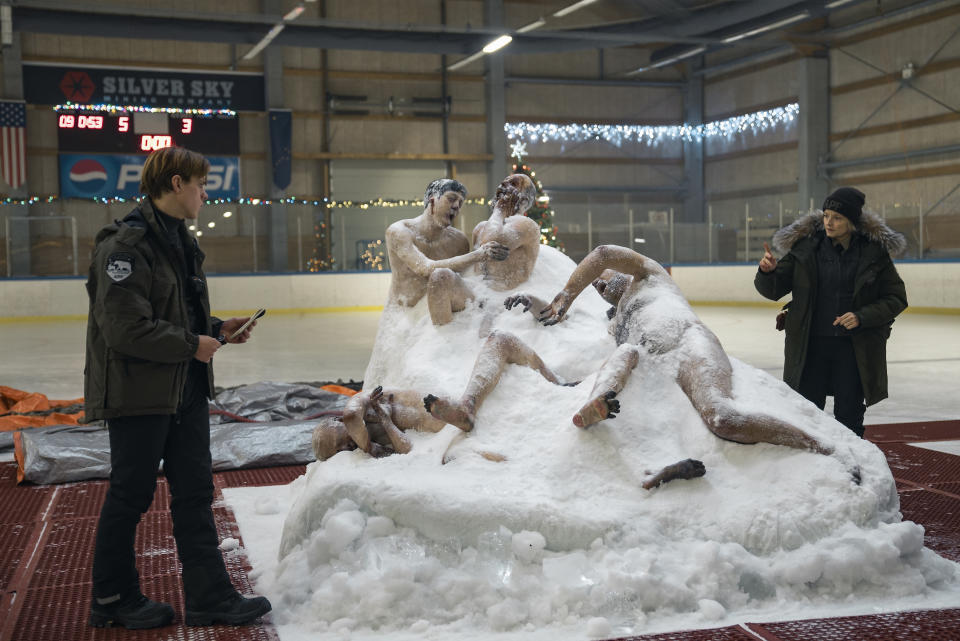
The Elseys used some Japanese artist’s models with poseable joints to rough out the eventual shape of the bodies, then created a digital model for the Elseys, López, and Taylor to tweak. They also needed to plan for the ice surrounding the dead men to be modular so that the corpsicle could be shot out of order, at various stages of thaw. “It was a sort of model kit,” Dave Elsey said. “It was quite a number of things to engineer and make sure everything all fit together before we even started doing any clay or photographs or measurements of any of the actors.”
But once the Elseys had an approved digital model and workable dimensions, they did have to bring in the actors — and take thousands of photographs of every part of their body, for reference. “The first time we ever met them, they all had to strip off down to their underwear, and we had to try to get them in the positions we needed,” Dave Elsey said. “You couldn’t have done plaster casts of them or anything, it would have been too complicated.”
It was still pretty complicated for the actors to twist into warped shapes in nothing but a Speedo with Issa López directing them over Zoom. “They were such good sports because they would just twist for us, and I’d be like, ‘OK, bend backwards. Open your mouth more. And now scream!’ And they’d be like, ‘Ah!’ and then we would [take the pictures] and capture the bodies to have every single angle,” López said.
With body references in hand — and actual casts of each of the actors’ heads, teeth, hands, and feet, as well — the Elseys adjusted the digital model and could create the ice blocks around them with the negative space in the digital environment around the bodies. “As [the ice] melted, we could sort of take bits of wire and then parts of the bodies could kind of fall off [and the ice could turn into] like a pile of snow or something like that,” Lou Elsey told IndieWire.
With all of this work done in advance, the Elseys could start milling body casts out of rigid foam. “Then we shaved those down by about a quarter of an inch all over so that we could then put a quarter of an inch of clay onto those foam scans, where we could then go in and add real minute details, skin pores and skin textures and things,” Dave Elsey said. “And also, we had to think about this, there was no way around it: genitalia.”
The HBO problem, shall we say, was not solved by taking casts or photos of any sort. The Elseys extrapolated from the information they had and kind of made up each victim’s genitals so they’d seem like a fit on the body and in its final position. “On top of that, we then also had to think about their injuries, like frostbite and all the things that had happened to them,” Lou Elsey said.
From these molds, the Elseys created dummies in silicon and did the work of building armatures, skin tones, punching in each and every hair, adding eyeballs, and all the stuff that truly sells a model as a dead body. “There’s teeth and tongues and all of those little things will have to be or had to be put in there as well. [We] just basically try and get as much detail and as much likeness as we could,” Lou Elsey said.
In Iceland and on Ice
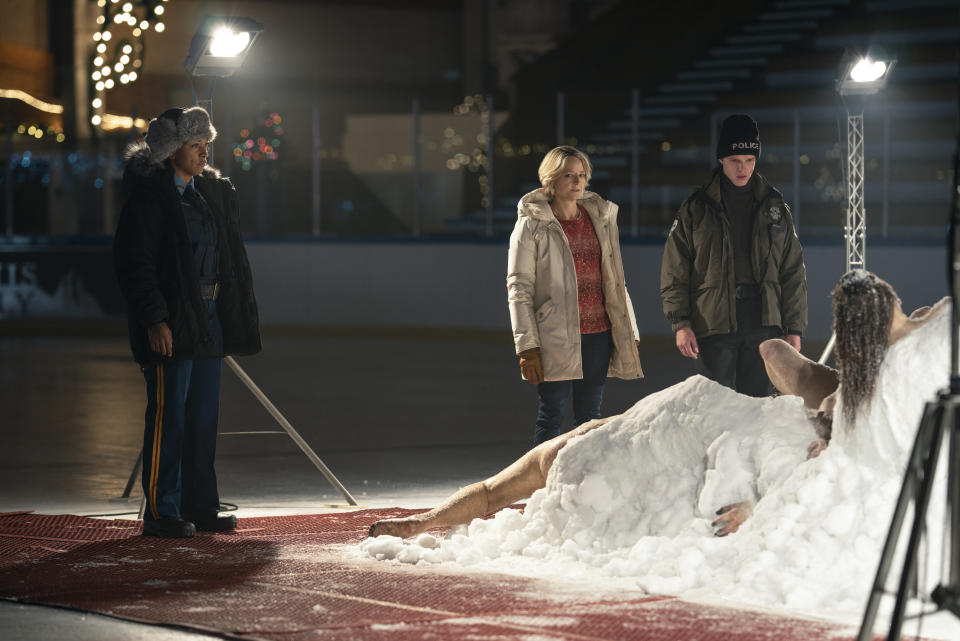
The first test for the Elseys’ work was safely shipping all of the modular pieces of the corpsicle from their workshop in London to Iceland for filming — it required commandeering a shipping container. But once the installation made it to Iceland, it was thrown under the fluorescent lights of the hockey rink.
“If you think about the dramatic arc they take, we discover them out in the snow and then the police clean them. So the audience would have had the horror of seeing them exposed to the elements, would have already been scared by them,” cinematographer Florian Hoffmeister said. “But as a film crew, we had to start with them in broad daylight, which was a bit of a challenge.”
Hoffmeister chose to light the rink, and indeed most of the man-made spaces in Ennis, extremely brightly — for a town in darkness, Hoffmeister reasoned, light is a self-soothing mechanism. He was nervous about whether the corpsicles would stand up to the glare or whether they would look a bit silly. “But the finish of them is crazy,” Hoffmeister said.
VFX supervisor Barney Curnow also said that his team stood by to jump in wherever the corpsicle needed a little bit more unlife. “There was some concern about how the corpsicle would grade, how it would come up on camera color-wise, because skin is quite tricky to get right — even frostbitten, frozen skin has that kind of waxy quality which is very difficult to get right in CG and using silicon,” Curnow told IndieWire. “In the end, it was very much as you see it.”
Curnow’s team was really freed to do minor detail work on the corpsicle after the fact: making eyes just that much milkier or bringing out frozen veins a little bit more. Which was for the best, because the VFX team had a complex job to do on top of the model of bodies and ice.
“The big thing, of course, that was continued to be talked about until quite close to shooting was when Lund [Þorsteinn Bachmann] wakes up,” Curnow said. That moment was always going to be a blend of SFX and VFX and actor performance — the Elseys built out a removable space inside the corpsicle for Bachmann to sit if they did end up filming the moment outside, “and he was apparently up for it,” Curnow said. “But we lined it up later, in a nice warm studio with green screen behind him so that we got those couple of shots in a more convivial environment.”
In a Hole in the Ground There Was a Corpsicle
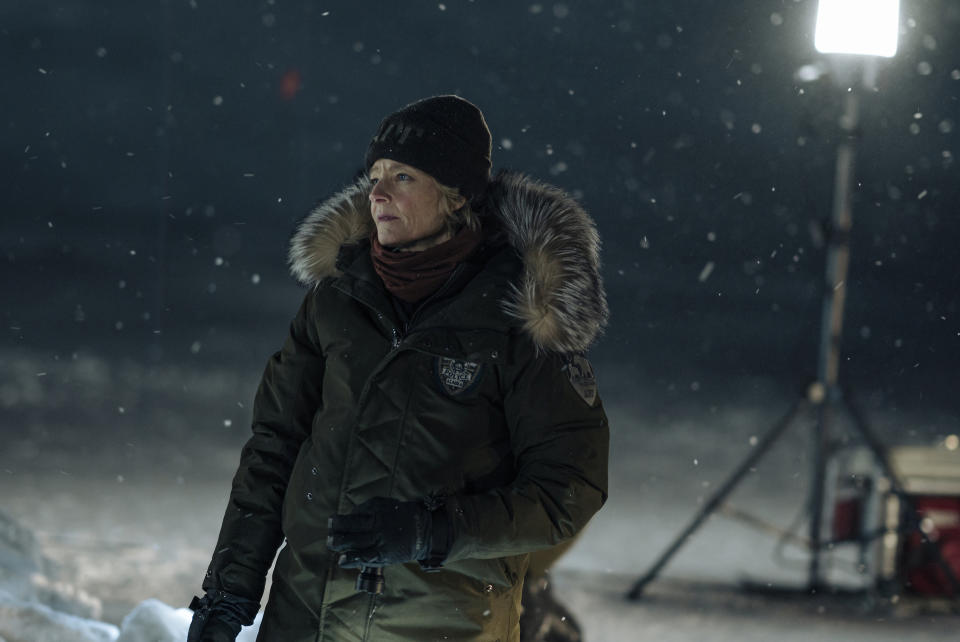
Many of the cast and crew of “True Detective: Night Country” did get to test the corpsicle in an extremely harsh environment: up a mountain in Iceland with a flat patch that could double for the frozen lake in the script. In advance of a January shoot date, Taylor and the production team needed to dig a hole in the ground that could fit the assembled corpsicle, with fake snow dressed on top so that the heads just poked above the ice.
“Needless to say, on the day, they kind of wanted it to be not facing that way, but facing [another] way. So we had to all clear it all out and get up again, move it slightly, and then bury it,” Taylor said. “And I’d had a phone call that evening from one of the special effects guys saying, ‘Yeah, we’ve covered over all of the bodies. You definitely can’t see any of the heads popping up now. So we’re good for tomorrow.’ So, we had to go back up, lift it up another couple of feet so you could see the first two heads poking through.”
“[The corpsicle] was very challenging because that was just such a big piece,” Lou Elsey said. Putting ice and snow on top of a model that already weighs “an absolute ton” was a gamble, let alone having to raise and reposition and rebury the piece for different shots out on the ice. “Like, you may have to wait until spring to get it out [again]. It might be impossible to get out because it might just ice itself,” Dave Elsey said.
But the corpsicle did perform exactly as intended and was removable — by a fairly hefty digger with chains. “It was really stunning to see, to be there and to see it in that environment, just the heads just sticking out,” Dave Elsey said.
“It’s a work of art. And it has to feel like art. Terrible dark art,” López said. “We were so worried up to the very last moment that it was not going to look cheesy or, you know, like something out of a mold, but [look] like a really frozen person. And it was so good, we didn’t have to hide anything. We could hold long shots on the faces and the feet and all the details. So I was very very satisfied with our little corpsicle.”
“True Detective: Night Country” premieres new episodes every Sunday on HBO.
Best of IndieWire
Where to Watch This Week's New Movies, Including 'Argylle' and 'How to Have Sex'
Christopher Nolan's Favorite Movies: 40 Films the Director Wants You to See
Sign up for Indiewire's Newsletter. For the latest news, follow us on Facebook, Twitter, and Instagram.

